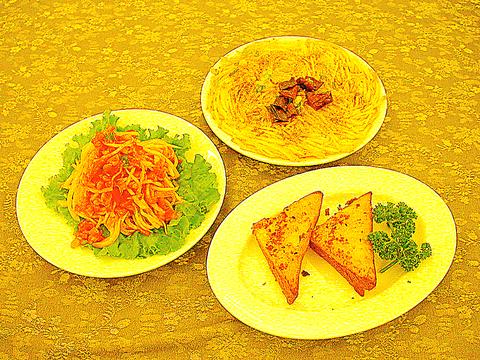Ren He Yuan is probably the most time-tested and authentic Yunnan restaurant in Taiwan. The fact that it is always full of customers testifies to the excellence of its cuisine. Although the restaurant never promotes itself as an "old shop," almost all of its regulars know that it started some 50 years ago and has moved and expanded several times because of its increasing popularity.
Trained under experienced Yunnan chefs, Ren He Yuan's cooks are good at turning seemingly homely dishes into delicacies. "There's no real spectacular or grandiose dish in Yunnan cuisine. Yunnan cuisine is composed of all kinds of homemade dishes," said Yao An-chin (姚安琴), proprietress of Ren He Yuan.
Yao knows the cooking style like the back of her hand, partly because of her background. Yao's father was a civil war veteran who took his Yunnan wife with him when the KMT government moved to Taiwan half a century ago. The veteran's community where they lived was nicknamed "Yunnan village" due to the presence of a large number of couples of that ethnic background. The community, in Taoyuan County's Pincheng, has remained one of the few places where you can find authentic Yunnan cuisine in Taiwan.

PHOTO: VICO LEE, TAIPEI TIMES
Dishes range from the exotic to the mundane. Their spicy stir-fried frogs (NT$248), tree roots with sweet sauce (NT$188), bamboo bugs with salt and pepper (NT$208) are Yunnan specialties rarely seen in Taiwan.
More common dishes such as guochiao rice noodles (NT$128) and bousu steamed buns (NT$20) are also on offer. This exclusive innovation is no less tasty than the traditional version. The buns, which come in sesame, ham and sugar filling and red bean filling, are among the best in Taipei. The sesame, ham and sugar filling is only moderately sweet but leaves a lingering taste.
One popular dish is eggplant with tomato and pork bits (NT$248). Like most other dishes in Ren He Yuan, it tastes naturally light, though the item is usually made to taste stronger and sometimes greasier in its place of origin. Frogs jumping over stone slabs (NT$288) contains peas instead of frogs, as "frog" is Yunan slang for "pea". The stone slabs are actually Yunnan cheese. However, the rarely available ingredient has been replaced by Taiwanese bamboo shoots. This has made the dish popular with the health-conscious.
As the restaurant has in recent years been increasingly popular with Japanese customers, which often outnumber local customers, it now also offers non-Yunnan dishes of fish and tofu to cater to Japanese tastes.
Although there is a long list of items on the menu, many dishes are not always available. These mostly include vegetables particular to Yunnan but difficult to import in large amounts.

The Taipei Times last week reported that the rising share of seniors in the population is reshaping the nation’s housing markets. According to data from the Ministry of the Interior, about 850,000 residences were occupied by elderly people in the first quarter, including 655,000 that housed only one resident. H&B Realty chief researcher Jessica Hsu (徐佳馨), quoted in the article, said that there is rising demand for elderly-friendly housing, including units with elevators, barrier-free layouts and proximity to healthcare services. Hsu and others cited in the article highlighted the changing family residential dynamics, as children no longer live with parents,

The classic warmth of a good old-fashioned izakaya beckons you in, all cozy nooks and dark wood finishes, as tables order a third round and waiters sling tapas-sized bites and assorted — sometimes unidentifiable — skewered meats. But there’s a romantic hush about this Ximending (西門町) hotspot, with cocktails savored, plating elegant and never rushed and daters and diners lit by candlelight and chandelier. Each chair is mismatched and the assorted tables appear to be the fanciest picks from a nearby flea market. A naked sewing mannequin stands in a dimly lit corner, adorned with antique mirrors and draped foliage

The election of Cheng Li-wun (鄭麗文) as chair of the Chinese Nationalist Party (KMT) marked a triumphant return of pride in the “Chinese” in the party name. Cheng wants Taiwanese to be proud to call themselves Chinese again. The unambiguous winner was a return to the KMT ideology that formed in the early 2000s under then chairman Lien Chan (連戰) and president Ma Ying-jeou (馬英九) put into practice as far as he could, until ultimately thwarted by hundreds of thousands of protestors thronging the streets in what became known as the Sunflower movement in 2014. Cheng is an unambiguous Chinese ethnonationalist,

I was 10 when I read an article in the local paper about the Air Guitar World Championships, which take place every year in my home town of Oulu, Finland. My parents had helped out at the very first contest back in 1996 — my mum gave out fliers, my dad sorted the music. Since then, national championships have been held all across the world, with the winners assembling in Oulu every summer. At the time, I asked my parents if I could compete. At first they were hesitant; the event was in a bar, and there would be a lot